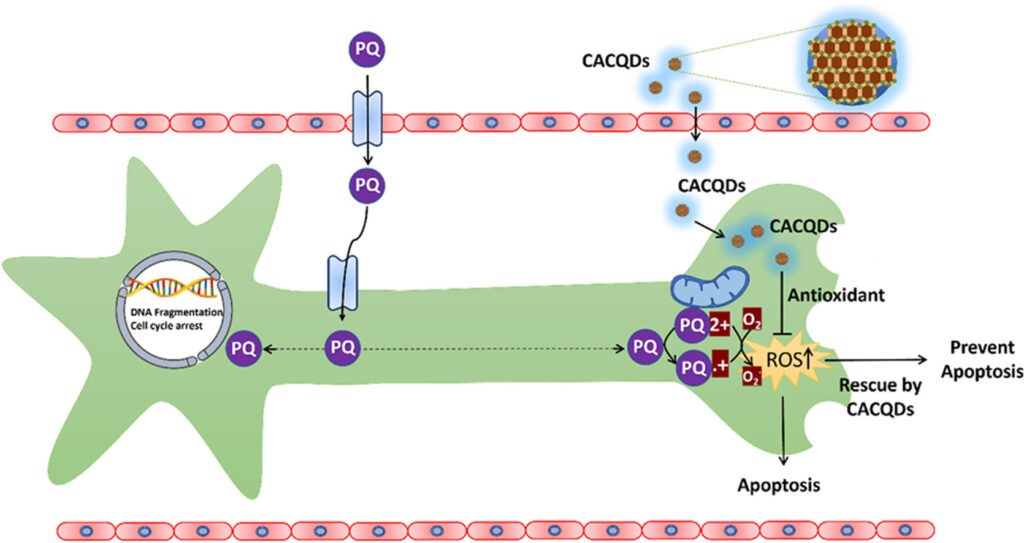From University of Texas at El Paso 29/11/23

Neurodegenerative disorders, including Alzheimer’s, Parkinson’s and Huntington’s, affect millions of people in the United States, and the cost of caring for people who live with these conditions adds up to hundreds of billions of dollars each year.
Now, researchers from The University of Texas at El Paso may potentially have found a solution in used coffee grounds — a material that is discarded from homes and businesses around the world every day.
A team led by Jyotish Kumar, a doctoral student in the Department of Chemistry and Biochemistry, and overseen by Mahesh Narayan, Ph.D., a professor and Fellow of the Royal Society of Chemistry in the same department, found that caffeic-acid based Carbon Quantum Dots (CACQDs), which can be derived from spent coffee grounds, have the potential to protect brain cells from the damage caused by several neurodegenerative diseases — if the condition is triggered by factors such as obesity, age and exposure to pesticides and other toxic environmental chemicals.
Their work is described in a paper published in the November issue of the journal Environmental Research.
“Caffeic-acid based Carbon Quantum Dots have the potential to be transformative in the treatment of neurodegenerative disorders,” Kumar said.
“This is because none of the current treatments resolve the diseases; they only help manage the symptoms.”

“Our aim is to find a cure by addressing the atomic and molecular underpinnings that drive these conditions.”
Neurodegenerative diseases are primarily characterized by the loss of neurons or brain cells.
They inhibit a person’s ability to perform basic functions such as movement and speech, as well as more complicated tasks including bladder and bowel functions, and cognitive abilities.
The disorders, when they are in their early stages and are caused by lifestyle or environmental factors, share several traits.
These include elevated levels of free radicals — harmful molecules that are known to contribute to other diseases such as cancer, heart disease and vision loss — in the brain, and the aggregation of fragments of amyloid-forming proteins that can lead to plaques or fibrils in the brain.
Kumar and his colleagues found that CACQDs were neuroprotective across test tube experiments, cell lines and other models of Parkinson’s disease when the disorder was caused by a pesticide called paraquat.
The CACQDs, the team observed, were able to remove free radicals or prevent them from causing damage and inhibited the aggregation of amyloid protein fragments without causing any significant side effects.
The team hypothesizes that in humans, in the very early stage of a condition such as Alzheimer’s or Parkinson’s, a treatment based on CACQDs can be effective in preventing full-on disease.
“It is critical to address these disorders before they reach the clinical stage,” Narayan said. “At that point, it is likely too late.
Any current treatments that can address advanced symptoms of neurodegenerative disease are simply beyond the means of most people.
Our aim is to come up with a solution that can prevent most cases of these conditions at a cost that is manageable for as many patients as possible.”
Caffeic acid belongs to a family of compounds called polyphenols, which are plant-based compounds known for their antioxidant, or free radical-scavenging properties.

Caffeic acid is unique because it can penetrate the blood-brain barrier and is thus able to exert its effects upon the cells inside the brain, Narayan said.
The process the team uses to extract CACQDs from used coffee grounds is considered “green chemistry,” which means it is environmentally friendly.
In their lab, the team “cooks” samples of coffee grounds at 200 degrees for four hours to reorient the caffeic acid’s carbon structure and form CACQDs.
The sheer abundance of coffee grounds is what makes the process both economical and sustainable, Narayan said.
The research was supported by a grant from the National Institutes of Health. In addition to Kumar, dozens of graduate and undergraduate UTEP students have worked on this project with Narayan including Sofia Delgado a former UTEP undergraduate student who is now pursuing her Ph.D. at Yale University.
The researchers will now seek additional funding to support further testing.
Narayan and Kumar both said they know the finish line is still far off. But, for now, they are moving forward on a journey that may ultimately lead to a medication – a pill, perhaps – that may prevent the vast majority of neurodegenerative disorders that are caused by factors other than genetics.



